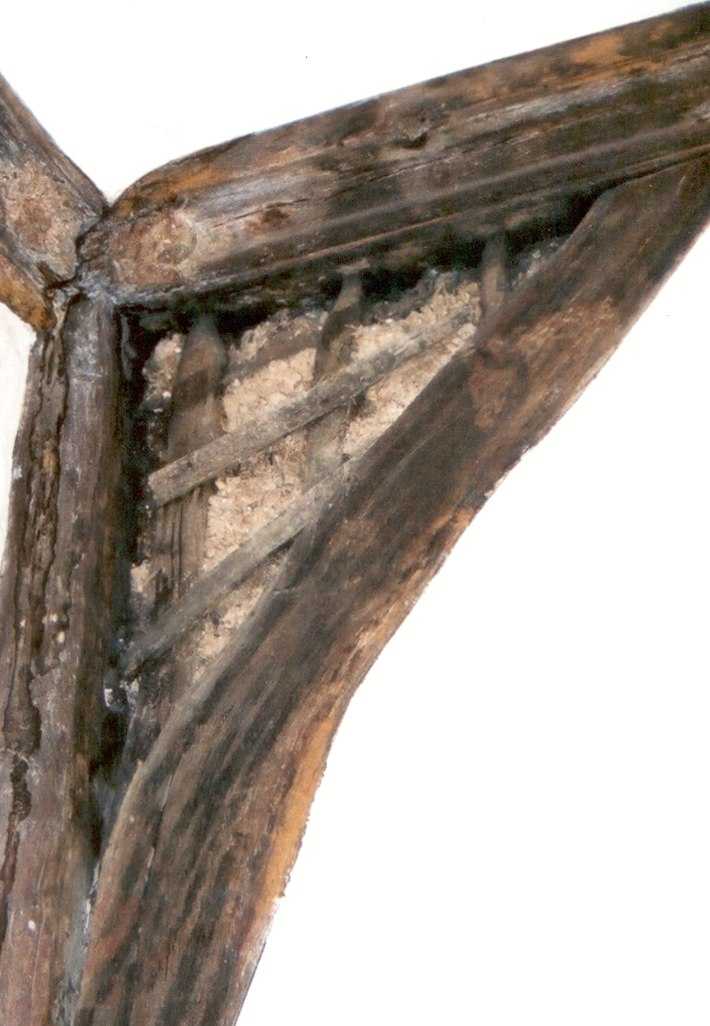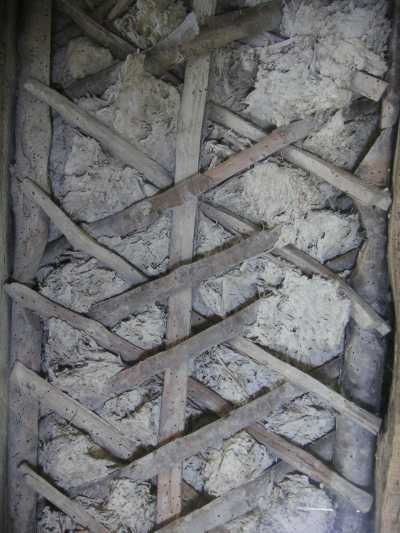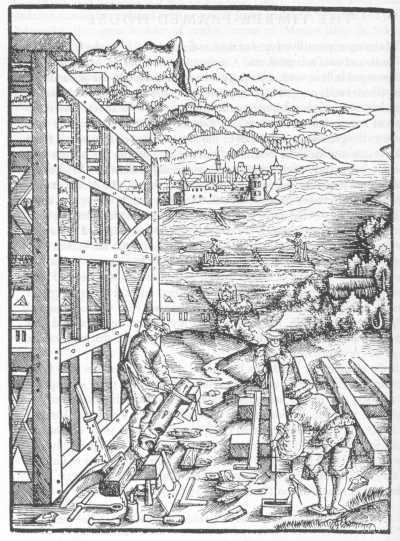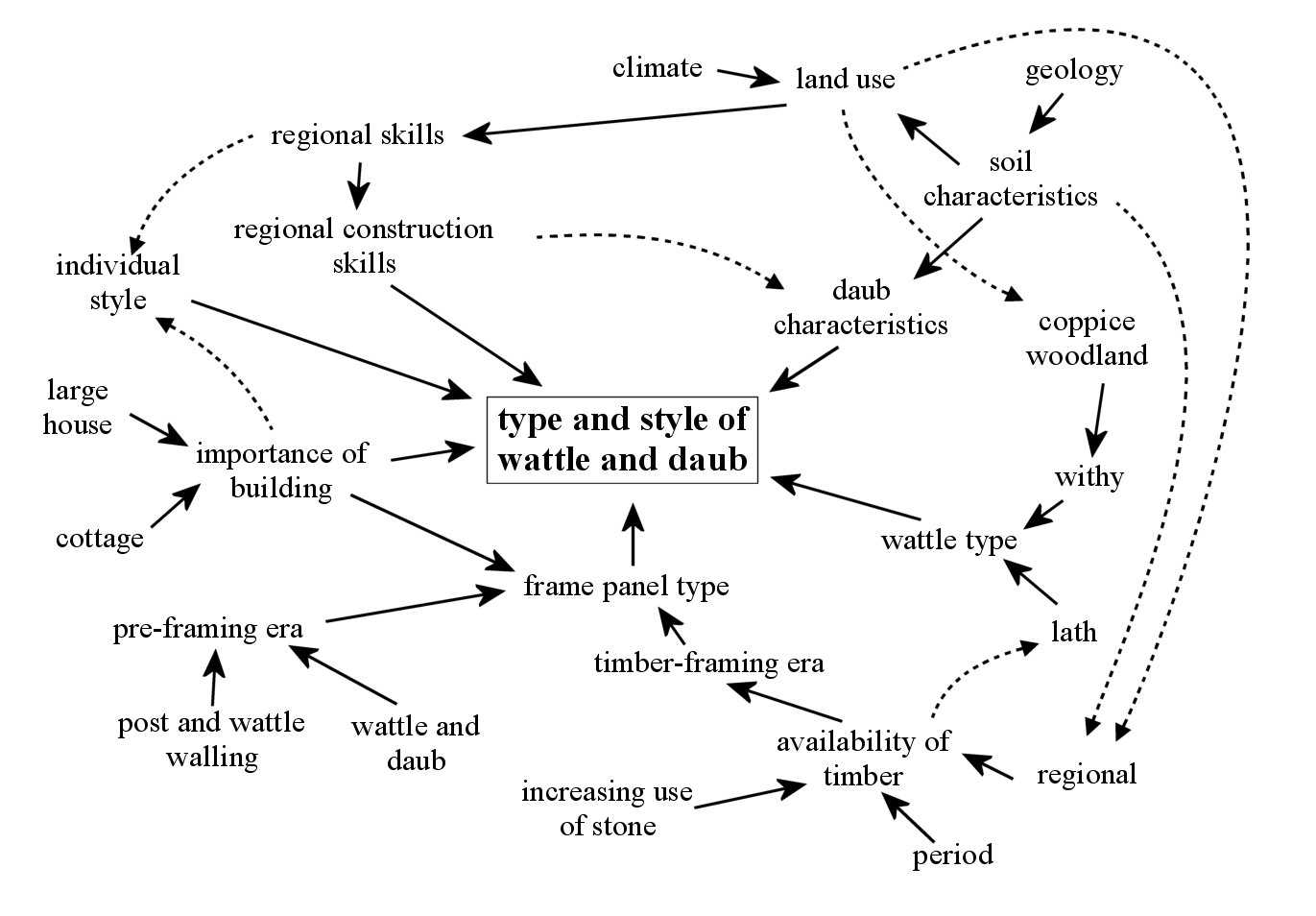Wattle & Daub: Craft, Conservation & Wiltshire Case Study
Contents
Contents
2 History
3 Craft
3.3 Panel Types
3.4 Staves
3.6 Daub
3.7 Decoration
4.1 Soils
4.1.1 Constituents
4.1.2 Plasticity
4.1.3 Strength
4.1.4 Field Testing
4.1.5 Selection
4.2 Dung
4.2.2 Lignin
4.2.3 Urine
4.2.4 Microbial Debris
4.2.5 The Role of Dung
4.3 Fibre
5.2.3 Maintenance
5.3 Repair
5.3.1 Partial Renewal
5.4 Replacement
5.4.1 Brick Infill
5.4.2 Renewal
6.3 Fieldwork
6.5 Evaluation
| Title Page Previous Next | Craft >Diversity of Style |
3.1 Diversity of Style
Identifying the origins of variation in wattle and daub is
complicated by the multitude of influencing factors and their interactions. In
fact, it was found that writing a full description was so prohibitively complex
that the map of Figure 5 was depicted.
Only a few of the secondary interactions (dashed lines) are shown, with others
excluded
fo[20]clarity.20
In considering some of the principal interactions, the dominating factor for wattle and daub style is panel type. This is primarily influenced by the type of construction, whether built during pre-framing or timber-framing eras and by the availability of timber. Access to suitable timber was regional, dependent on geology and past land use. The material chosen for rebuilding was increasingly influenced by availability of good building stone versus the scarcity of timber and the reluctance to timber due to fire risk. The distribution of today’s wattle and daub styles is compounded by the probability of building survival and, in turn, this is dependent on the eminence of the building.[21]
Where wattle and daub does survive, the materials used are dependent on the landscape and its historic uses. For example, the underlying geology not only determines whether a daub might contain chalk rather than other aggregate, but also determines the agricultural use of the land, such as shepherding on the downs versus woodland in the vales. Further, the availability of chalk or limestone would affect the likelihood of a daub being gauged with lime. It also follows that these factors affect demography, for example through the skill of hurdle-making for sheep penning, and is also recursive since the materials for penning take the sequence back to a dependence for coppice.
The availability of coppice woodland versus timber trees would also influence the use of withies versus riven (split) lath, but the latter is preferable for infill of close studding and hence selection is entwined with panel type.
 |
 |
Variation of wattle and daub is also affected by the
multitude of methods available to the individual dauber or peasant cottage
builder, even within a single locality. This may therefore mask the
identification of regional variation since subtleties are difficult to identify
without increasing the sample size of inspected buildings. Unfortunately, the
scarcity of exposed wattle and daub makes studies difficult and the return on
investment in time taken to increase sample size by seeking out additional
examples becomes increasingly poor. However, on the positive side, it is because
of this diversity of methods and materials that it is still common to find new
variations when investigating infill panels in historic buildings [Figure 6 and Figure 7].
 |
||||
|
|
|
|||
 |
||||
|
|
|
|||
[20]
For example, climate also affects geology, such as the landscape of northern
England being influenced by glacier action and deposits, but has been excluded
for clarity.
[21]
Brunskill developed a model titled the ‘vernacular zone’ that
describes the survival of historic buildings in terms of their status and
age.
